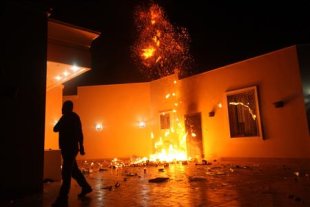
The early details sketch out a chaotic situation in which apparently outgunned U.S. and Libyan security personnel fought for hours to retake the diplomatic compound in the eastern Libyan city from unknown gunmen and lost the ambassador. The account was provided to reporters on the condition that the officials giving it not be identified.
At about 10 p.m. local time in Benghazi, the compound housing the American diplomatic mission came under fire "from unidentified Libyan extremists," one of the officials said. Just 15 minutes later, the attackers had breached the perimeter and trained their fire on the main building, setting it ablaze.
Inside were Stevens, a regional security officer and Sean Smith, an information management officer with the State Department who was also killed. (Overall, the compound had about 25 to 30 people in it.)
"They became separated from each other due to the heavy, dark smoke while they were trying to evacuate the burning building," one official said. The security officer and others returned into the burning building to find the ambassador and Smith. "This was really quite a heroic effort."
"At that time, they found Sean.?He was already dead, and they pulled him from the building," the official said. "They were unable, however, to locate Chris before they were driven from the building due to the heavy fire and smoke and the continuing small arms fire."
At 10:45 p.m., security personnel tried to retake the main building but were repelled.?At 11:20 p.m., U.S. and Libyan security forces were able to retake the main building, evacuating personnel they found there to an annex. That annex came under fire at midnight, an onslaught that lasted two hours and claimed the lives of two more Americans and wounded another two. By 2:30 a.m., Libyan forces helped the Americans to take control.
"At some point in all of this?and frankly, we do not know when?we believe that Ambassador Stevens got out of the building and was taken to a hospital in Benghazi. We do not have any information what his condition was at that time. His body was later returned to U.S. personnel at the Benghazi airport," an official said. "I think it was already dawn in Libya."
"There are reports out there that I cannot confirm that he was brought to the hospital by Libyans who found him," the official said. "Obviously, he had to get there somehow. No Americans were responsible for that."
"We were not able to see him until his body was returned to us at the airport," an official said when asked to confirm whether Stevens died from smoke inhalation. "You can imagine that we will not be able to say anything about the cause of death until we've had a chance to perform an autopsy."
American authorities brought in a chartered aircraft from Tripoli to Benghazi to evacuate all of the Americans to Tripoli. From there, they were evacuated to Germany.
The officials repeatedly ducked questions about Stevens' security arrangements. And they offered no details about the protests that reportedly came before the attack.
But they disputed the notion that he was under-protected.
"There was no information and there were no threat streams to indicate that we were insufficiently postured," one official said.
capital one bowl winter classic 2012 georgia bulldogs football rashard mendenhall rachel zoe penn state football mt rainier national park
কোন মন্তব্য নেই:
একটি মন্তব্য পোস্ট করুন